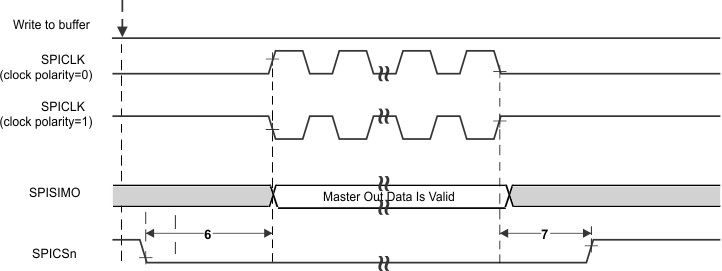SWRS237B April 2020 – July 2022 IWR6843AOP
PRODUCTION DATA
- 1 Features
- 2 Applications
- 3 Description
- 4 Functional Block Diagram
- 5 Revision History
- 6 Device Comparison
- 7 Terminal Configuration and Functions
-
8 Specifications
- 8.1 Absolute Maximum Ratings
- 8.2 ESD Ratings
- 8.3 Power-On Hours (POH)
- 8.4 Recommended Operating Conditions
- 8.5 Power Supply Specifications
- 8.6 Power Consumption Summary
- 8.7 RF Specification
- 8.8 CPU Specifications
- 8.9 Thermal Resistance Characteristics for FCBGA Package [ALP0180A]
- 8.10
Timing and Switching Characteristics
- 8.10.1 Antenna Radiation Patterns
- 8.10.2 Antenna Positions
- 8.10.3 Power Supply Sequencing and Reset Timing
- 8.10.4 Input Clocks and Oscillators
- 8.10.5
Multibuffered / Standard Serial Peripheral Interface (MibSPI)
- 8.10.5.1 Peripheral Description
- 8.10.5.2
MibSPI Transmit and Receive RAM Organization
- 8.10.5.2.1 SPI Timing Conditions
- 8.10.5.2.2 SPI Controller Mode Switching Parameters (CLOCK PHASE = 0, SPICLK = output, SPISIMO = output, and SPISOMI = input) (1) (1) (1)
- 8.10.5.2.3 SPI Controller Mode Switching Parameters (CLOCK PHASE = 1, SPICLK = output, SPISIMO = output, and SPISOMI = input) (1) (1) (1)
- 8.10.5.3 SPI Peripheral Mode I/O Timings
- 8.10.5.4 Typical Interface Protocol Diagram (Peripheral Mode)
- 8.10.6 LVDS Interface Configuration
- 8.10.7 General-Purpose Input/Output
- 8.10.8 Controller Area Network - Flexible Data-rate (CAN-FD)
- 8.10.9 Serial Communication Interface (SCI)
- 8.10.10 Inter-Integrated Circuit Interface (I2C)
- 8.10.11 Quad Serial Peripheral Interface (QSPI)
- 8.10.12 ETM Trace Interface
- 8.10.13 Data Modification Module (DMM)
- 8.10.14 JTAG Interface
- 9 Detailed Description
- 10Monitoring and Diagnostics
- 11Applications, Implementation, and Layout
- 12Device and Documentation Support
- 13Mechanical, Packaging, and Orderable Information
Package Options
Refer to the PDF data sheet for device specific package drawings
Mechanical Data (Package|Pins)
- ALP|180
Thermal pad, mechanical data (Package|Pins)
Orderable Information
8.10.5.2.3 SPI Controller Mode Switching Parameters (CLOCK PHASE = 1, SPICLK = output,
SPISIMO = output, and SPISOMI = input)(1)(2)(3)
| NO. | PARAMETER | MIN | TYP | MAX | UNIT | ||
|---|---|---|---|---|---|---|---|
| 1 | tc(SPC)M | Cycle time, SPICLK(4) | 25 | 256tc(VCLK) | ns | ||
| 2(4) | tw(SPCH)M | Pulse duration, SPICLK high (clock polarity = 0) | 0.5tc(SPC)M – 4 | 0.5tc(SPC)M + 4 | ns | ||
| tw(SPCL)M | Pulse duration, SPICLK low (clock polarity = 1) | 0.5tc(SPC)M – 4 | 0.5tc(SPC)M + 4 | ||||
| 3(4) | tw(SPCL)M | Pulse duration, SPICLK low (clock polarity = 0) | 0.5tc(SPC)M – 4 | 0.5tc(SPC)M + 4 | ns | ||
| tw(SPCH)M | Pulse duration, SPICLK high (clock polarity = 1) | 0.5tc(SPC)M – 4 | 0.5tc(SPC)M + 4 | ||||
| 4(4) | td(SPCH-SIMO)M | Delay time, SPISIMO valid before SPICLK low, (clock polarity = 0) | 0.5tc(SPC)M – 3 | ns | |||
| td(SPCL-SIMO)M | Delay time, SPISIMO valid before SPICLK high, (clock polarity = 1) | 0.5tc(SPC)M – 3 | |||||
| 5(4) | tv(SPCL-SIMO)M | Valid time, SPISIMO data valid after SPICLK low, (clock polarity = 0) | 0.5tc(SPC)M – 10.5 | ns | |||
| tv(SPCH-SIMO)M | Valid time, SPISIMO data valid after SPICLK high, (clock polarity = 1) | 0.5tc(SPC)M – 10.5 | |||||
| 6(5) | tC2TDELAY | Setup time CS active until SPICLK high (clock polarity = 0) | CSHOLD = 0 | 0.5*tc(SPC)M + (C2TDELAY + 2)*tc(VCLK) – 7 | 0.5*tc(SPC)M + (C2TDELAY+2) * tc(VCLK) + 7.5 | ns | |
| CSHOLD = 1 | 0.5*tc(SPC)M + (C2TDELAY + 2)*tc(VCLK) – 7 | 0.5*tc(SPC)M + (C2TDELAY+2) * tc(VCLK) + 7.5 | |||||
| Setup time CS active until SPICLK low (clock polarity = 1) | CSHOLD = 0 | 0.5*tc(SPC)M + (C2TDELAY+2)*tc(VCLK) – 7 | 0.5*tc(SPC)M + (C2TDELAY+2) * tc(VCLK) + 7.5 | ||||
| CSHOLD = 1 | 0.5*tc(SPC)M + (C2TDELAY+3)*tc(VCLK) – 7 | 0.5*tc(SPC)M + (C2TDELAY+3) * tc(VCLK) + 7.5 | |||||
| 7(5) | tT2CDELAY | Hold time, SPICLK low until CS inactive (clock polarity = 0) | (T2CDELAY + 1) *tc(VCLK) – 7.5 | (T2CDELAY + 1) *tc(VCLK) + 7 | ns | ||
| Hold time, SPICLK high until CS inactive (clock polarity = 1) | (T2CDELAY + 1) *tc(VCLK) – 7.5 | (T2CDELAY + 1) *tc(VCLK) + 7 | |||||
| 8(4) | tsu(SOMI-SPCL)M | Setup time, SPISOMI before SPICLK low (clock polarity = 0) | 5 | ns | |||
| tsu(SOMI-SPCH)M | Setup time, SPISOMI before SPICLK high (clock polarity = 1) | 5 | |||||
| 9(4) | th(SPCL-SOMI)M | Hold time, SPISOMI data valid after SPICLK low (clock polarity = 0) | 3 | ns | |||
| th(SPCH-SOMI)M | Hold time, SPISOMI data valid after SPICLK high (clock polarity = 1) | 3 | |||||
(1) The MASTER bit (SPIGCRx.0) is set and the CLOCK PHASE bit (SPIFMTx.16) is set ( where x = 0 or 1 ).
(2) tc(MSS_VCLK) = main subsystem clock time = 1 / f(MSS_VCLK). For more details, see the Technical Reference Manual.
(3) When the SPI is in Controller mode, the following must be true: For PS values from 1 to 255: tc(SPC)M ≥ (PS +1)tc(MSS_VCLK) ≥ 25 ns, where PS is the prescale value set in the SPIFMTx.[15:8] register bits. For PS values of 0: tc(SPC)M = 2tc(MSS_VCLK) ≥ 25 ns.
(4) The active edge of the SPICLK signal referenced is controlled by the CLOCK POLARITY bit (SPIFMTx.17).
(5) C2TDELAY and T2CDELAY is programmed in the SPIDELAY register
 Figure 8-8 SPI Controller Mode External Timing (CLOCK PHASE = 1)
Figure 8-8 SPI Controller Mode External Timing (CLOCK PHASE = 1) Figure 8-9 SPI Controller Mode Chip Select Timing (CLOCK PHASE = 1)
Figure 8-9 SPI Controller Mode Chip Select Timing (CLOCK PHASE = 1)